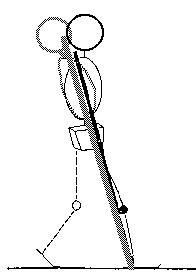Leaning backward during loading response inclines the ground reaction force vector posteriorly from its point of application at the hindfoot. Because the vector passes closer to the hip joint's lateral axis, its moment arm is shorter, and it produces a smaller hip flexor moment.
THIS GAIT DEVIATION IS ALSO CALLED A GLUTEUS MAXIMUS LIMP, SINCE IT OFTEN SIGNIFIES WEAKNESS IN THAT MUSCLE GROUP.
